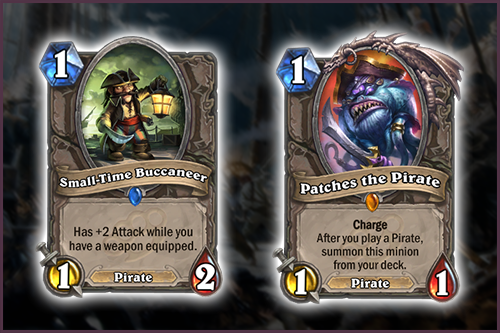vS Data Reaper Presents: How Impactful is Small-Time Buccaneer, Patches and the Pirate Package? 
Since the release of Mean Streets of Gadgetzan, a key cornerstone of the Meta have been decks built around pirate synergy, featuring Patches the Pirate and Small-Time Buccaneer, which has turned out to be one of the most powerful 1 drops ever printed. Rogue found itself back on the map with the ability to dagger up on turn 2 and control the board or push damage with an early 3/2. Shaman received yet another powerful early game minion along with a key pair of early game weapons. Warrior benefited from existing pirate and weapon synergies. The dominance of the pirate package has led to the announcement of balance changes to take place at the end of this season, specifically targeting Small-Time Buccaneer and Spirit Claws – two cards frequently used in tandem to efficiently eliminate opposing threats while pushing large chunks of damage early in the game.
We’ve been working on this analysis long before the balance changes were announced. We wanted to try to answer the question of how impactful the pirates really are. Before we get into this, just to reiterate our standard caveat about data – we are not dealing in absolutes here and data as a whole can provide answers to very specific questions. We will learn below what generally happens when certain cards are played on certain turns, but we do not know what would happen if the cards weren’t played, nor do we know the context of the games, specific deck variations or player skill differentials. What we will identify are trends – when a player does a specific thing on a specific turn, generally this is what happens. It is important to note that the underlying assumption is that when a player does something, it is the best move they could make, according to their assessment.
The following statistics are win rates of the four main pirate decks, as well as occurrence rates for the relevant events. Our analysis is based on the results of approximately 500,000 games since the expansion’s release. All of this data is based on turn 1 events, the most important turn of the game when it comes to the pirate package. We’ll have two tables and charts for all four decks: one based around Patches the Pirate and one based on turn 1 plays, specifically Small-Time Buccaneer along with a class specific 1 drop. Note that the win rates themselves are aggregates over this period of time, so it’s more important to focus on the differentials in win rates caused by certain events, rather than the values themselves which are less meaningful for the analysis.
Let’s take a look at Pirate Warrior first:

| Base | Draw patches | No pirate | Cannon | ||
| Win Rate | No coin | 50.35% | 36.08% | 44.93% | 55.91% |
| Coin | 52.27% | 38.45% | 50.05% | 56.19% | |
| Occurrence Rate | No coin | 15.3% | 84.7% | ||
| Coin | 14.7% | 85.3% |
The first chart tells the story of Patches. The “base” percentage on the left is the total win rates of all games we have in our database broken down to going first or second. The second column is the win rate if a pirate is played on turn 1 and Patches is in your hand, the third is if you don’t play any pirate at all on turn 1, and the fourth is if you play a pirate on turn 1 and Patches gets shot out of the cannon. We also show the occurrence rates of Patches in hand or out of the cannon, conditional on a pirate being played.
As you can tell, the win rate differential between drawing Patches or not is absolutely massive – in all situations, it’s worse to draw Patches than to not play any pirate at all. Unfortunately, there’s not much player agency here, and this might be the root of some of the community issues surrounding this card, the difference in win rates between getting Patches compared to not getting it on turn 1 is between 17% and 20%! The loss of on-board tempo combined with having a Stonetusk Boar in your hand instead of a more powerful card is significant enough to drop your win rate down to below 40% in this case.

| Base | No STB | STB | No NFM | NFM | Neither | Either | ||
| Win Rate | No coin | 50.35% | 48.14% | 55.01% | 48.13% | 56.56% | 42.15% | 55.77% |
| Coin | 52.27% | 51.31% | 54.06% | 48.98% | 58.21% | 46.80% | 55.24% | |
| Occurrence Rate | No coin | 67.8% | 32.2% | 73.6% | 26.4% | 41.6% | 58.4% | |
| Coin | 67.4% | 32.6% | 64.3% | 35.7% | 40.2% | 59.8% |
The second chart tells us the story of 1 drops. The base column remains the same as above and after that you will see the performance of Small-Time Buccaneer and a class-specific 1-drop, in this case N’Zoth’s First Mate. The far right two columns combine the data and check to see if either of the 1 mana minions was played on turn 1 or not. There’s lots of interesting data to go through here. First of all, Small-Time Buccaneer is actually not the most powerful pirate in the deck when played on turn 1! When going first, Small-Time Buccaneer impacts the win rate by 6.9%, but on the coin it’s only a 2.8% increase over not having it. N’Zoth’s First Mate, on the other hand, generates an 8.4% increase when going first, and on the coin it gets you a staggering 9.2% boost. The results with the coin may be an indication of the synergy of the minions when played together, which is hinted by the higher drop rates of N’Zoth’s First Mate on the coin (since NFM is not just a minion, but a weapon that activates STB). However, this doesn’t explain N’Zoth’s First Mate superior performance when going first, which is an indication of the Warrior’s dependence on weapon synergy and availability of early game removal more than anything else. Still, having either 1 drop is incredibly important, especially going first – the win rate difference between having these 1 drops vs. not having them is 13.6%. Note that Pirate Warrior performs better with the coin, which is consistent with past analysis on the subject.
Not all warriors are created equal, though. Here are the results for Dragon Warrior, which retains some popularity on ladder. The deck includes the pirate package as well, so what does the data tell us in the context of this archetype?

| Base | Draw patches | No pirate | Cannon | ||
| Win Rate | No coin | 52.91% | 39.78% | 45.75% | 61.75% |
| Coin | 50.00% | 40.38% | 45.3%% | 56.43% | |
| Occurrence Rate | No coin | 16.1% | 83.9% | ||
| Coin | 15.9% | 84.1% |

| Base | No STB | STB | No NFM | NFM | Neither | Either | ||
| Win Rate | No coin | 52.91% | 50.34% | 58.96% | 50.42% | 61.00% | 44.92% | 59.94% |
| Coin | 50.00% | 48.94% | 52.72% | 46.70% | 57.47% | 45.06% | 54.64% | |
| Occurrence Rate | No coin | 70.2% | 29.8% | 76.4% | 23.6% | 46.7% | 53.3% | |
| Coin | 70.9% | 29.1% | 69.3% | 30.7% | 47.2% | 52.8% |
It’s clear that this is a very different deck. For starters, this is a deck that wins more on the play than on the coin – the extra card matters less than the initiative the deck needs to get ahead and stay ahead. The early game is so important that you will see even larger win rate differentials here based on both Patches and which 1 drop you play – drawing Patches will cost you between 16% and 22%!
N’Zoth’s First Mate continues to surprise and will get you an increase in win rate of just over 10.5% compared to not having it, while Small-Time Buccaneer improves your win rate on the play (8.6%) but on the coin will gain you just under 4%. Dragon Warrior depends on having a 1 drop even more than Pirate Warrior and having one of these two cards on turn 1 when going first will win you the game an incredible 15% of the time more often, while with the coin the value is 9.6%.
Turn 1 also matters a lot to decks that are used to pushing initiative, not just damage – and there’s no better example of this than Miracle Rogue.

| Base | Draw patches | No pirate | Cannon | ||
| Win Rate | No coin | 49.79% | 39.40% | 42.46% | 58.14% |
| Coin | 51.54% | 41.75% | 47.46% | 56.62% | |
| Occurrence Rate | No coin | 16.8% | 83.2% | ||
| Coin | 17.4% | 82.6% |

| Base | No STB | STB | No SWB | SWB | Neither | Either | ||
| Win Rate | No coin | 49.79% | 45.71% | 57.64% | 48.65% | 54.13% | 38.58% | 56.34% |
| Coin | 51.54% | 48.74% | 56.51% | 51.32% | 52.31% | 42.74% | 55.07% | |
| Occurrence Rate | No coin | 65.9% | 34.1% | 79.2% | 20.8% | 45.2% | 54.8% | |
| Coin | 65.1% | 34.9% | 77.2% | 22.8% | 41.4% | 58.6% |
The deck with the biggest win rate discrepancy depending on having a turn 1 play is Miracle Rogue. Patches increases your win differential by similarly large percentages as above – 18.7% on the play, 14.9% on the coin – but Small-Time Buccaneer matters even more here. We’re looking at an 11.93% difference going first and 7.8% with the coin. If you include the data for Small-Time Buccaneer as well as Swashburglar, you will increase your win rate by an unbelievable 17.8% going first and 12.3% going second by playing a Pirate on turn 1.
Finally, let’s talk about the boogeyman of the format… Aggro Shaman.

| Base | Draw patches | No pirate | Cannon | ||
| Win Rate | No coin | 56.88% | 40.28% | 55.08% | 62.89% |
| Coin | 51.73% | 38.81% | 50.29% | 56.79% | |
| Occurrence Rate | No coin | 15.3% | 84.7% | ||
| Coin | 14.7% | 85.3% |

| Base | No STB | STB | No Trogg | Trogg | Neither | Either | ||
| Win Rate | No coin | 56.88% | 54.20% | 63.02% | 55.04% | 61.71% | 49.67% | 62.43% |
| Coin | 51.73% | 49.84% | 56.24% | 50.12% | 55.17% | 47.96% | 54.11% | |
| Occurrence Rate | No coin | 69.6% | 30.4% | 72.4% | 27.6% | 42.1% | 57.9% | |
| Coin | 71.6% | 28.4% | 70.2% | 29.8% | 47.2% | 52.8% |
The first thing you should notice is that those base win rates are pretty high – it’s the best deck in the game, after all. The win rate difference between drawing Patches vs. getting him out of the cannon going first is 22.6%! On the coin, it’s an 18% difference.
When it comes to 1 drops, this is the only deck we looked at where we picked a non-pirate 1 drop as a reference – good old Tunnel Trogg, which is one of the most powerful one drops in the history of the game. According to this data, Trogg is not as powerful as Small-Time Buccaneer, which should tell us a lot. Small-Time will get you an increase of between 6.4% and 8.8% in win rate while Tunnel Trogg will be about 5% to 6.6%. Having a 1 drop is very important going first and will net a 12.8% increase, but going second our data only accounts for about a 6.15% increase. This is likely because Aggro Shaman has very powerful 2-drops it can coin out on turn 1 to shore up its curve.
Out of all four decks, the single highest win rate scenario is Aggro Shaman going first with a Small-Time Buccaneer. Our data indicates this will win you the game 63% of the time. The balance changes seem to be quite appropriate, though it remains to be seen whether it will be enough to change who’s in charge now.
Let us know what questions you have in the comments. Thank you!
Our Data Reaper Project, including the Data Reaper Live (Beta) has 2,300 active contributors. Without them, analysis such as this would not be possible, so we’d like to thank all of our contributors for their help.






大変貴重なデータ。わかりやすく、かつ自明であり、この情報が得られた事が大変嬉しい。データを提供してくださった方々、そしてこの膨大なデータを分析しその上公開してくださったRIDICUROUSHAT氏、PROZACH氏、ZACHO氏に圧倒的感謝を。
どういたしまして!私たちはあなたが楽しかったのでうれしいです。 Google翻訳がうまくいけばいいですね。 🙂
Hello everyone,
A reddit user requested some statistics on double 1-drop turns, so I have put together the following rough data for winrates for your perusal.
Aggro shaman: Coin STB x2 60.36% winrate, coin trogg x2 60.38% winrate, coin any combination of these two 1-drops 61.44%
Pirate war: Coin STB x2 57.68% winrate, coin nfm x2 42.11% winrate, coin any combination of these two 1-drops 58.97%
Dragon war: Coin STB x2 50.13% winrate, coin nfm x2 33.33% winrate, coin any combination of these two 1-drops 55.94%
Miracle rogue: Coin STB x2 54.33% winrate, coin swash x2 38.46% winrate, coin any combination of these two 1-drops 51.46%
Unfortunately we can’t tell in the “combination” percentages which two 1-drops were played, but this is still interesting data – it seems in Aggro Shaman and Pirate War matchups it’s definitely correct (as long as you’re not going double n’zoth’s first mate…) whereas in Miracle it’s definitely incorrect. Dragon warrior is right in between.
Great analysis, including the additional comment by RidiculousHat, I had the same question!
Nice data. Well done.
I always wanted to know if stb was the stronger opening than tt. And now i know it. Great.
Thanks a lot.
And thanks at blizz that these changes are coming.